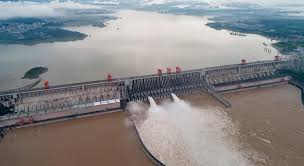China Launches Construction of World’s Largest Hydropower Dam in Tibet
China has officially started building the world’s largest hydropower dam in the Yarlung Tsangpo canyon, a move that has triggered serious concerns in India and Bangladesh over the project’s environmental and geopolitical impact.
🚧 Massive Project in Strategic Tibetan Location
On July 13, Chinese Premier Li Qiang led the inauguration ceremony for the new dam, located in Tibet’s Yarlung Tsangpo River—known downstream as the Siang and Brahmaputra Rivers in India and Jamuna in Bangladesh. The project, officially named the Motuo Hydropower Station, will reportedly cost 1.2 trillion yuan (around $167 billion).
Once complete, the dam will surpass the current world record-holder, the Three Gorges Dam, and is expected to generate three times more electricity, making it a key asset in China’s national energy strategy.
🌍 Why India and Bangladesh Are Worried
Experts warn that this dam could give China greater control over vital water resources that flow into India and Bangladesh, posing both environmental and political risks. A 2020 Lowy Institute report stated that China’s hold over these rivers grants it a “chokehold on India’s economy.”
Arunachal Pradesh Chief Minister Pema Khandu recently warned the press that the dam could significantly reduce river flow and cause an “existential threat” to local tribes like the Adi people. He also raised fears of the dam being used as a “water bomb”, causing floods by suddenly releasing water downstream.
India’s Ministry of External Affairs has formally raised its objections and stressed the need for transparency and consultation with downstream nations.
🔧 Engineering Feats and Environmental Red Flags
China plans to construct the dam through massive tunnels—some stretching 20 kilometers long—under Namcha Barwa, the mountain around which the river makes its famous “Great Bend.” The steep drop in elevation makes it an ideal location for high-yield hydropower.
Chinese engineers aim to create five cascading power stations by straightening the river’s flow and redirecting it through these tunnels. While Beijing claims the electricity will benefit both Tibet and other regions, critics say most of the power is headed for China’s eastern cities, not local communities.
🌱 Environmental and Human Rights Concerns
Tibetan valleys in the dam area are rich in biodiversity, and experts warn that flooding the region for the reservoir could destroy ecologically sensitive zones. The area also lies along active earthquake fault lines, raising the risk of disaster.
Human rights activists have also criticized the project as another example of China exploiting Tibetan land and silencing dissent. In 2024, protests against a different dam in Tibet were met with mass arrests and reported beatings.
⚡ Powering China’s East with Tibet’s Rivers
This project is part of President Xi Jinping’s national energy strategy, dubbed “xidiandongsong”—which translates to “send western electricity eastward.” It aims to leverage Tibet’s natural resources to meet the growing power demands of China’s major cities.
While Chinese state media presents the project as a “green energy solution” that will help reduce pollution and develop Tibet, local resistance and international pushback are mounting.
Key Takeaways:
- China begins construction of the world’s largest hydropower dam in Tibet.
- India and Bangladesh express deep concerns over water flow control and ecological damage.
- Project cost: $167 billion, with plans to generate 3x more electricity than the Three Gorges Dam.
- Dam could displace tribes and destroy biodiversity in seismically sensitive areas.
- India plans its own dam as a countermeasure on the Siang River.






